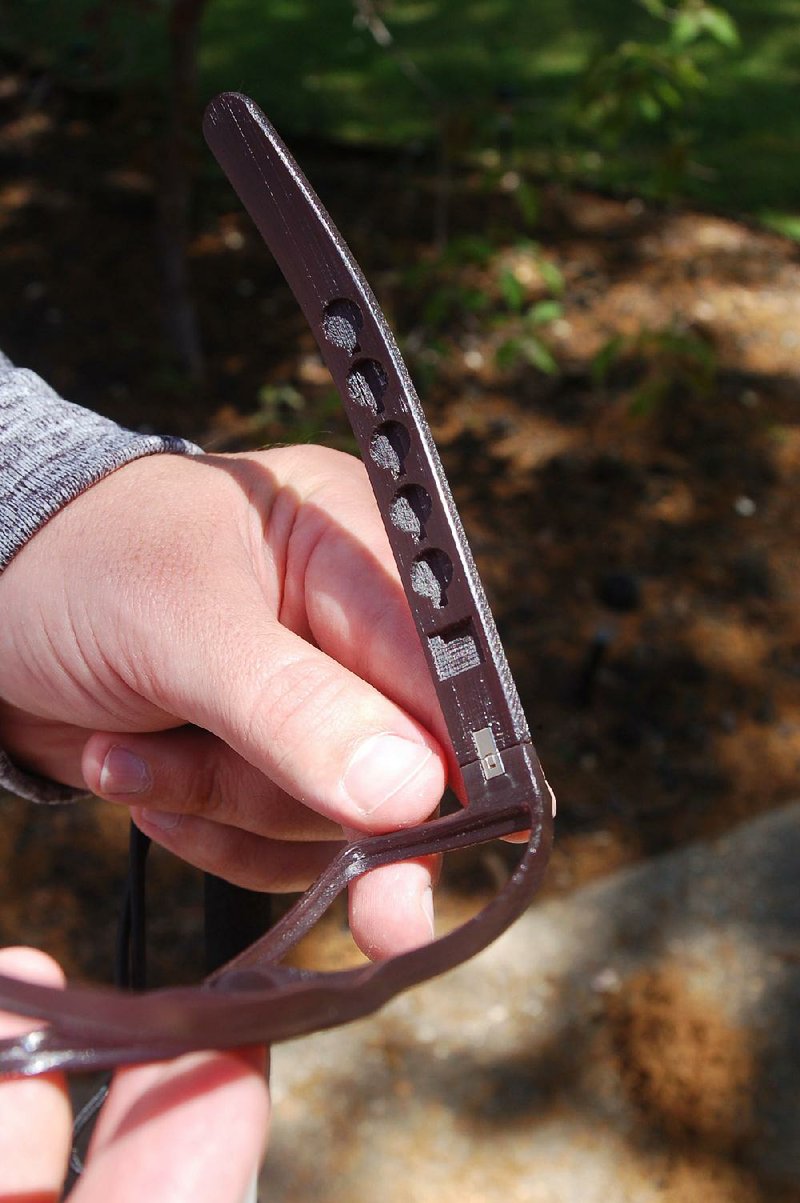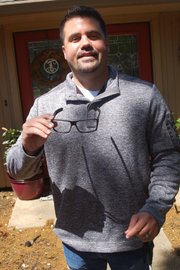MAGNOLIA -- Since Brandon Foshee lost his sight 15 years ago while in college, little has changed to help the blind find their way in a world built for the sighted. He's trying to do something about it.
Foshee formed Fauxsee Innovations -- a play on his last name -- in 2011 and set about developing "eyeglasses" for the blind. He calls them Roboglasses.
He has received about $600,000 in grants from several agencies, including the National Institutes of Health, the National Science Foundation, the U.S. Department of Agriculture and state entities that help with the development of small businesses.
The U.S. Patent and Trademark Office has granted Foshee two patents, in 2014 and 2017, for the glasses.
In August, in Little Rock, Fauxsee will hold a human trial for Roboglasses. It will involve about 20 volunteers winding their way through an obstacle course, hoping the glasses will alert them to potential hazards, from about waist- to head-high, that sometimes aren't detected by guide dogs and canes.
"Forty-six percent of the blind sustain head injuries at some point, with 23 percent of those requiring medical attention of some sort," Foshee, 37, said recently from his home in Magnolia, just off the edge of the campus of Southern Arkansas University where some of the research behind his glasses is being conducted.
The trials in August will be important in the continued development of Roboglasses, especially for the glasses approval as a medical device by the U.S. Food and Drug Administration.
"We'll design a course that can be easily changed around so that one person who takes multiple trips will find a different route and different obstacles each time," Foshee said. "Water noodles might represent a branch at head high. Other pieces of foam could represent an open cabinet door or a street sign. A cane or guide dog will alert the blind to a signpost, but not necessarily to the sign itself."
Each pair of glasses used in the trial will be interfaced with a computer. "This will show how well the sensors are firing," he said. "If someone hits an obstacle, we'll know."
Between now and August, Dr. Nicholas Giudice, a professor of spatial informatics at the University of Maine, will study the Roboglasses as part of the grant from the National Institutes of Health.
"People have been working on electronic travel aids for the blind since the 1960s," Giudice said by telephone last week. "They usually don't get out of the lab or the design phase, sometimes because they're designed by a person with sight who's looking for a solution to a problem that doesn't exist. This is different, because Brandon is blind and I am blind and that leads to something distinctive about the development and research behind his glasses."
Roboglasses, if successful, will complement, not replace, the traditional guide dog and cane, Giudice said. "The purpose of all these tools is to help detect and avoid hazards, but the cane and the dog sometimes don't help much with hazards higher up," Giudice said, recalling how he once "knocked myself out at the gym" when he walked into the edge of an interior, open-frame stairwell.
Other glasses on the market wouldn't have helped him in that situation, he said.
One product, called OrCam, reads texts, menus and other printed material and feeds the information audibly to the user. Another, called Aira, is a subscription service set of "smart glasses" that sends a live video feed to a waiting "agent," who then guides the user through whatever he needs.
OBSTACLE ALERTS
Foshee was 12 the first time his vision blurred, and doctors warned that it could get worse.
It did, when he was 22 and in college at Southern Arkansas University. The optic nerve in his left eye ruptured, leaving him blind in that eye. Six months later, scar tissue took the rest of his vision.
"I have zero light perception, which means I'm totally blind," Foshee said.
"The idea [for Roboglasses] got started in a conversation with a friend, who asked if there was anything for the blind, besides a service dog or a cane," Foshee said. "There wasn't. I learned pretty quickly that a ball cap helped some -- the bill touches something before it hits me, like an open cabinet door or the door left open to a microwave that's at head level."
Technology is finally catching up with the needs of the blind, he said. "It took a while to be able to make things small enough to actually be practical and usable," he said, referring to various sensors and receptors key to the Fauxsee technology.
In layman's terms, Roboglasses will consist of an ordinary-looking pair of black plastic glasses, with a switch for indoor and outdoor use.
Each lens will have a sensor about the size of a dime. "Think of the rearview sensor that's on some cars now, giving the driver a picture, or an alert, to what's behind him," Foshee said. (A longer-term project is to have a single sensor in the bridge of the frames to determine distance to an object and whether it's to the left or right.)
Each stem of the glasses will have five linear resonant actuators -- small vibrating motors about the size of watch batteries -- to alert the user based on what the lens sensors pick up.
Indoors, the first actuator on each stem alerts the user to an obstacle at 6 feet, and whether the hazard is to the left or right, with each successive actuator judging hazards a foot closer. In the outdoor mode, each actuator gauges distances of 3 feet. "We travel faster outdoors than we do indoors," Foshee said.
Each actuator has 123 "haptic" -- or touch -- sensations, allowing the user to select a specific alert for each distance and direction through an accompanying computer program.
"A blind person uses hearing to look for hazards," Foshee said. "The hum of a refrigerator lets me know where I am in the kitchen, but other sounds interfere with that. Previous efforts [on glasses] used sounds and vibrations, but vibrations are annoying and disruptive and sometimes are even audible to someone you're talking to."
Foshee and his wife, Megan, who teaches nursing at SAU and is trial coordinator for Fauxsee, have been invited to give a presentation of the company and glasses at a conference June 29 in Bethesda, Md., commemorating the 50th anniversary of the National Institutes of Health.
He hopes to have the glasses on the market next year at an estimated price of $2,500, and have a manufacturing plant in Magnolia.
Approval from the FDA will make Roboglasses eligible for coverage under Medicare and Medicaid.
"Seventy percent of the blind are unemployed, so Medicaid and Medicare are essential," Foshee said. "We could sell without FDA approval but likely won't. But I'd hate to say no to someone who really needs and wants the glasses."
SundayMonday Business on 05/13/2018

